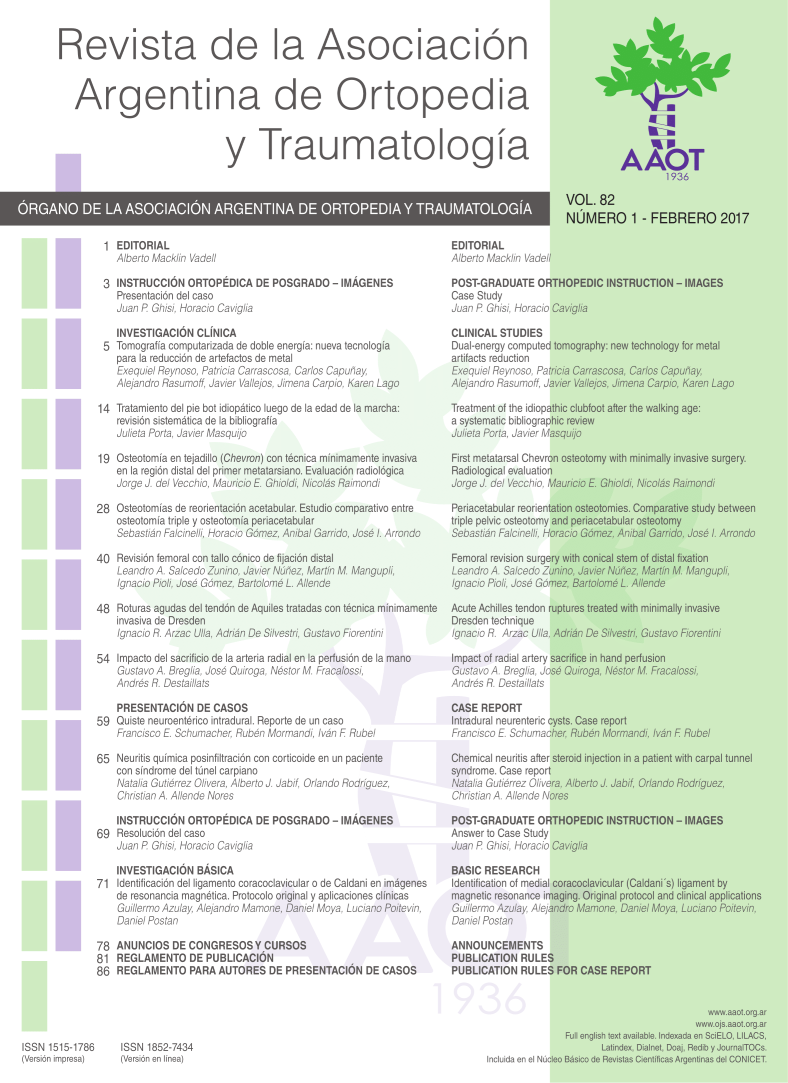Identificación del ligamento coracoclavicular medial o de Caldani en imágenes de resonancia magnética. Protocolo original y aplicaciones clínicas. [Identification of medial coracoclavicular (Caldani's) ligament by magnetic resonance imaging. Original protocol and clinical applications.]
Contenido principal del artículo
Resumen
Descargas
Métricas
Detalles del artículo

Esta obra está bajo licencia internacional Creative Commons Reconocimiento-NoComercial-CompartirIgual 4.0.
La aceptación del manuscrito por parte de la revista implica la no presentación simultánea a otras revistas u órganos editoriales. La RAAOT se encuentra bajo la licencia Creative Commons 4.0. Atribución-NoComercial-CompartirIgual (http://creativecommons.org/licenses/by-nc-sa/4.0/deed.es). Se puede compartir, copiar, distribuir, alterar, transformar, generar una obra derivada, ejecutar y comunicar públicamente la obra, siempre que: a) se cite la autoría y la fuente original de su publicación (revista, editorial y URL de la obra); b) no se usen para fines comerciales; c) se mantengan los mismos términos de la licencia.
En caso de que el manuscrito sea aprobado para su próxima publicación, los autores conservan los derechos de autor y cederán a la revista los derechos de la publicación, edición, reproducción, distribución, exhibición y comunicación a nivel nacional e internacional en las diferentes bases de datos, repositorios y portales.
Se deja constancia que el referido artículo es inédito y que no está en espera de impresión en alguna otra publicación nacional o extranjera.
Por la presente, acepta/n las modificaciones que sean necesarias, sugeridas en la revisión por los pares (referato), para adaptar el trabajo al estilo y modalidad de publicación de la Revista.
Citas
2. Rouvière H. Anatomie Humaine Descriptive et Topographique, Masson, Paris; 1927 (2). p.36.
3. StedmanT L. A practical medical dictionary, New York, W. Wood and company; 1920. P. 153.
4. Poitevin L, Postan D. Moya, D, Valente S, Azulay G.; Mamone A, Giacomelli Anatomía del Ligamento Córaco-clavicular Medial. Primera Parte: Investigación Anatómica.. Rev. Arg. Anat. Onl.2014, Vol. 5, Nº 4: 119 – 126.
5. Vallois, HV; Thomas, L: Les formations fibreuses du triangle clavipectoral. Arch Anato Hist Embr.1942; 3: 363-396.
6. Souteyrand-Boulanger. Les formations fibreuses et les ligaments du triangle clavi-coraco-pectoral chez les primates. Mammalia. 1966;30: 645-666.
7. Stimec et al. Medial coraco-clavicular ligament revisted: an anatomic study and review of the literature. Arch Orthop Trauma Surg. 2012;132(8):1071-5. doi: 10.1007/s00402-012-1512-9.
8. Poitevin L: Compressions à la confluence cervico-braquiale. En: Tubiana R. Traité de Chirurgie de la Main. Masson, Paris, Volume 4, 1991:368-369.
9. Poitevin L: Proximal compressions of the upper limb neurovascular bundle. An anatomic research study. Hand Clinics. 1988 (l4). 4:575-584.
10. Poitevin L: Proximal compressions of the upper limb neurovascular bundle. En Tubiana R: The Hand. WB Saunders Volume IV, 1993 Chapter 20: 338-339.
11. Poitevin, LA. Bases anatómicas de las compresiones cervicobraquiales. Parte I: factores estáticos. Rev. Asoc. Argent. Ortop. Traumatol; 1988, 53(2): 175-88.
12. Poitevin, LA. Bases anatómicas de las compresiones cervicobraquiales. Parte II: Factores dinámicos. Patogenia de las compresiones. Rev. Asoc. Argent. Ortop. Traumatol; 1988, 53(2): 199-212.
13. Dolan CM, Hariri S, Hart ND et al. An anatomic study of the coracoid process as it relates to bone transfer procedures. J Shoulder Elbow Surg. 2011; 20:497–501. DOI: 10.1016/j.jse.2010.08.015
14. Ockert B, Braunstein V, Sprecher C et al. Attachment sites of the coracoclavicular ligaments are characterized by fibrocartilage differentiation: a study on human cadaveric tissue. ScandJMedSci Sports. 2010;22(1): 12-17. DOI: 10.1111/j.1600-0838.2010.01142.x.
15. Rockwood CA Jr, Matsen FA, Wirth MA, Lippitt SB. The Shoulder, 4th ed. W. B. Saunders, Philadelphia, 2009: 216–386.
16. Lädermann A, Grosclaude M, Lubbeke A et al Acromioclavicular and coracoclavicular cerclage reconstruction for acute acromio-clavicular joint dislocations. J Shoulder ElbowSurg. 2011, 20:401–408. DOI: 10.1016/j.jse.2010.08.007.
17. Klassen JF, Morrey BF, An Kn. Surgical anatomy and function of the acromioclavicular and coracoclavicular ligaments. Op Tech Sport Med. 1997;5(2):60-64.
18. Stoller DW: Magnetic Resonance Imaging in Orthopaedics and Sports Medicine Philadelphia: Lippincott-Raven Publishers, Third Edition, Nov 2006. ISBN-13: 978-0781773577
19. Vahlensieck M: MRI of the shoulder. Eur Radiol. 2000;10(2):242-9.
20. Ho CP. Applied MRI anatomy of the shoulder. J Orthop Sports Phys Ther. 1993 Jul;18(1):351-9.
21. Lee JC, Guy S, Connell D, Saifuddin A, Lambert S. Ho CP: MRI of the rotator interval of the shoulder. Clin Radiol. 2007, 62(5):416-23. DOI: 10.1016/j.crad.2006.11.017
22. Nakata W, Katou S, Fujita A, Nakata M, Lefor AT, Sugimoto H. Biceps pulley: normal anatomy and associated lesions at MR arthrography. Radiographics. 2011, 31(3):791-810. DOI: 10.1148/rg.313105507

